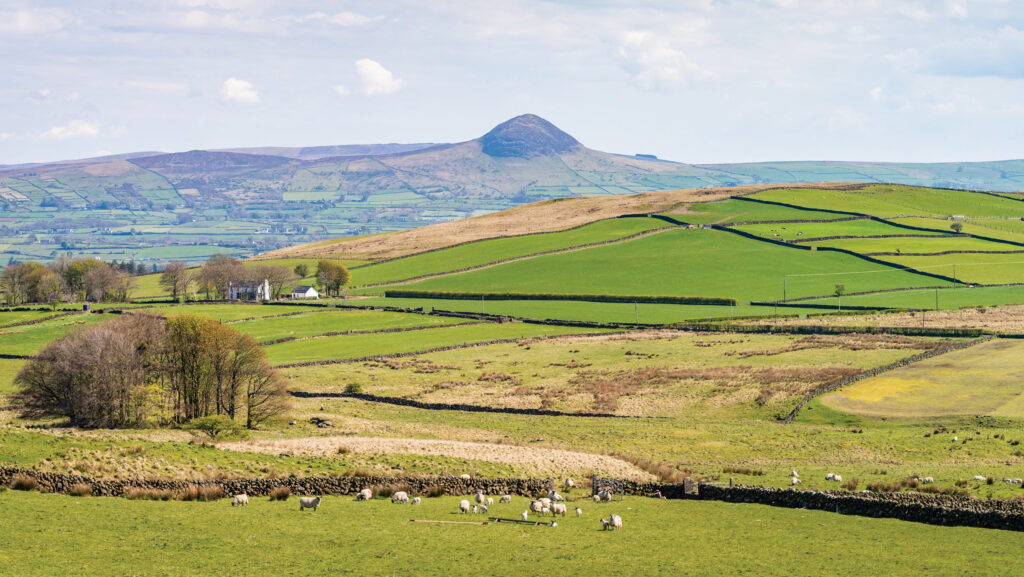Business Clinic: Should we use a trust to protect assets?
 Panoramic scenery over the braid valley and County Antrim hills, Northern Ireland, with Slemish mountain in the distance, on a sunny day with clouds in the sky, and sheep in the foreground, and lots of old stone walls separating the fields
Panoramic scenery over the braid valley and County Antrim hills, Northern Ireland, with Slemish mountain in the distance, on a sunny day with clouds in the sky, and sheep in the foreground, and lots of old stone walls separating the fields Whether it’s a legal, tax, insurance, management or land issue, Farmers Weekly’s Business Clinic experts can help.
Carly Drummond, senior tax manager at accountant MHA advise on the many considerations of putting farmland and buildings into a discretionary trust
Q. I am advised to place farmland worth about £675,000 into a discretionary trust to protect it for our two adult children and future grandchildren. We are concerned about the possibility of divorce/bankruptcy issues in their lifetimes, so asset protection is our main objective.
However, I am unsure about the tax situation on transfer to my trustees. My wife and I (67 and 65) have owned and farmed the land here in Northern Ireland for more than 10 years in our names, some set in conacre (seasonal lets), so would we have to inform HMRC if we transfer the land to our trustees, to maintain the inheritance tax (IHT) relief at 100% which would be available if we died?
Other farm assets, such as outbuildings, are valued at about £120,000. Would the value of these also be free from IHT once transferred to our trustees?
Also, it is possible to have any conacre payments made to my wife and I kept separate from the trust structure, or does this have to be declared as trust income?
Trusts are an excellent planning tool where you wish to retain control of assets but want to relinquish ownership.
It is important to consider the types of trusts during the planning process. In this case, a discretionary trust (DT) has been suggested.
See also: Business Clinic: how do we structure our business succession?
A DT will result in the trustees, possibly the settlors, being responsible for the trust’s actions and acting in the best interest for the beneficiaries – in this question the lineal family.
DTs are used frequently where the objective is to “protect” assets, be that from marital or financial issues.
With a DT, the trustees can distribute income and capital at their discretion.
Based on the information available and assumptions: the partnership is comprised of the assets mentioned; you and your wife are farming in partnership, and; the partnership meets the “wholly and mainly” tests, then it is likely the transfer to trust will qualify for business property relief (BPR) and agricultural property relief (APR).
It is vital to make this initial assessment prior to settling assets into trust in order to mitigate any IHT events.
IHT considerations
The proposed value of the land is £675,000. This would be more than the two IHT nil rate bands available (assuming no other trust settlements in previous years) of £650,000 (£325,000 each).
The excess will likely not give rise to lifetime IHT charges at 20% on the basis that relief applies to the assets. The same rules would apply should the outbuildings be included.
Capital gains tax (CGT) would be relevant, but assuming you are transferring into a non-settlor interested trust, you could use holdover relief to defer the gain, resulting in the trustees taking on the historic base cost.
Alternatively, if the partnership will cease on the transfer of the land to trust, you may wish to consider triggering a ‘dry’ tax charge to utilise your business asset disposal relief (BADR) lifetime allowances if available.
This would see you benefit from the reduced 10% CGT rate on the transfer which may not be available in future if the land were sold by the trustees.
In this case the trustees would take on the land at current market values resulting in a lower gain being chargeable to them on the event of a future sale.
If the partnership continues to farm the trust land it would need to do so under a rental agreement.
This would be deemed a third party tenancy, meaning business property relief (BPR) would no longer apply, and we would need to rely on an application of agricultural property relief after seven years.
Alternatively, the trust could farm the land in hand and meet the wholly or mainly test to qualify for BPR in its own right after two years.
If they are also transferred to the trust, the outbuildings, provided they are used in agriculture and the requisite ownership period for trustees is met, would be expected to benefit from IHT relief.
Legal advice needed
The land being transferred into the trust would need to be subject to the existing conacre agreements – we recommend this is checked by your legal advisers.
If you wish to continue to receive the conacre income, you should really consider whether this is the right time to transfer this land into trust.
To take this point even further, you must understand that should either of you retain any benefit in the trust land, be that via income or capital payments, the trust will be deemed settlor-interested.
This will remove the IHT and CGT benefits attached to the creation of the trust.
Finally, yes, you would need to report the proposed transfer to HMRC.
The transfer value is in excess of 80% of your NRBs and therefore the details need to be reported, including any relief claimed.
Do you have a question for the panel?
Outline your legal, tax, finance, insurance or farm management question in no more than 350 words and Farmers Weekly will put it to a member of the panel. Please give as much information as possible.
Email your question to FW-Businessclinic@markallengroup.com using the subject line “Business Clinic”.
